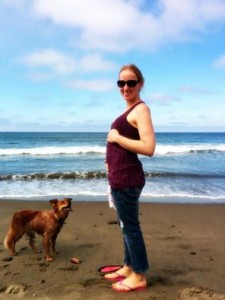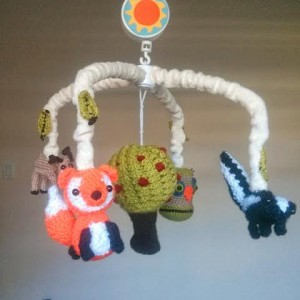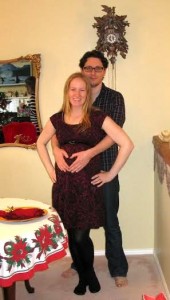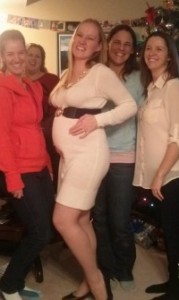December 29 – January 4: 28 Weeks 0 Days – 28 Weeks 6 Days.
Update: This post generated a great discussion on Facebook. I concede that this post should actually be named “13 Misconceptions I Had About The Research About Babies.” Real babies can be quite different from theoretical babies. More updates below on individual points.
People say all the time that you can never be ready for pregnancy, childbirth, or parenthood, but reading up on and preparing for these stages at least makes me feel ready. I’m two-thirds done pregnancy, I’ve read several books about it, I’m going to regular prenatal visits at my hospital, I’m enrolled in a birth prep class, my birth and postpartum doulas are hired… I feel that doing much more would be over-preparing for birth. As such, I’ve chosen to move on to reading about newborn care. After poring over online reviews, I chose two baby books to read:
- Baby 411 by Ari Brown and Denise Fields. This book struck me as one that would contain conventional, mainstream advice on newborn care.
- The Baby Book by the Doctors Sears. This book struck me as a little more hippy-dippy-touchy-feely (i.e. totally up my alley), as it encourages attachment parenting.
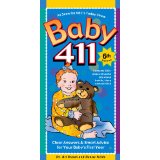 These books are both tomes, so Richard and I chose to each tackle one. I decided that since my intuitions would probably gravitate more toward the Baby Book and his toward Baby 411, we should swap to read the book that would give us different perspective. I just finished reading Baby 411, and the chapters on newborn care were informative, non-judgmental, and easy to read. I didn’t enjoy the (many) chapters about everything that can go wrong with the baby, but the conditions were presented in a non-alarming way and I’ll be glad to have all that information for reference when I’m wondering if my baby’s latest rash is anything to worry about. The vaccinations chapter aside (which was strongly pro-vax—I happen to agree so it didn’t bother me), Baby 411 focused on giving the reader straight-up information, rather telling the reader what to do, so parents could draw their own conclusions.
These books are both tomes, so Richard and I chose to each tackle one. I decided that since my intuitions would probably gravitate more toward the Baby Book and his toward Baby 411, we should swap to read the book that would give us different perspective. I just finished reading Baby 411, and the chapters on newborn care were informative, non-judgmental, and easy to read. I didn’t enjoy the (many) chapters about everything that can go wrong with the baby, but the conditions were presented in a non-alarming way and I’ll be glad to have all that information for reference when I’m wondering if my baby’s latest rash is anything to worry about. The vaccinations chapter aside (which was strongly pro-vax—I happen to agree so it didn’t bother me), Baby 411 focused on giving the reader straight-up information, rather telling the reader what to do, so parents could draw their own conclusions.
My biggest take-away from reading Baby 411 was that many of the opinions I held about newborn care were kind of ignorant, based mainly on things I’d heard, not on actual science or evidence. I don’t like to think of myself as judgmental—previously, if I saw a baby using a pacifier, I wouldn’t think anything as blatant as, Omg, I can’t bu-lieve those parents are using a pacifier. That is SO bad for the baby. But I might think something more subtly judgmental like, Ah, this must be a fussy baby and the parents need to use a pacifier for their own sanity. I didn’t occur to me that maybe these parents were more educated than me and made a carefully informed choice to use a pacifier to best support their baby’s health (see below for more on pacifiers). Baby 411 certainly put me in my place.
Here are Thirteen Misconceptions I Had About Babies, and what Baby 411 had to say about them. Some of these statements are not categorically false—just much more nuanced than I realized:
Misconception #1: You can train newborns to sleep when you want them to. I didn’t necessarily think this was a good idea (see next my point), but I did think it was possible. According to Baby 411 it’s not: newborns are not developmentally capable of falling asleep on their own. Intense sleep training before five or six months will be futile and detrimental to the baby. In fact, the authors also say that “you can’t spoil a newborn” because bad sleep habits don’t develop until after two months of age. As such, all the “rules” for promoting independent sleep go out window for newborns (e.g. don’t breastfeed the baby to sleep). Parents can unabashedly do whatever it takes (within reason, of course) to get a newborn to sleep.
Misconception #2: Letting a baby “cry it out” will mess her up.
Update: A better statement of my misconception would be “Research strongly suggests that letting a baby ‘cry it out’ will definitely, for sure, mess her up.” This was my misconception, but it doesn’t mean the exact opposite is true (i.e. Letting a baby “cry it out” is definitely, for sure, not going to mess up any child). Reality is something more like, “Research is equivocal about the safety of the ‘cry it out; method.”
I’ve heard and read this so many times that I assumed there was hard evidence backing this statement, but it actually stands on shaky ground, scientifically. Proviso: As mentioned above, the baby must be neurologically mature enough to settle on her own (five to six months), and shouldn’t be left to cry it out when she needs a diaper change, is hungry, or there’s an underlying medical reason for her crying. The two main ways to teach a baby to sleep on her own are Rapid extinction/Cry it out (which I’d be too much of a worrywart to handle) and Progressive Waiting/Ferberizing (which I would be more comfortable with). Interestingly, many infant sleep disorders are attributed to excessive parental intervention (e.g. Soothing a baby to sleep then putting her to bed—when she wakes up briefly as part of her natural sleep cycle she’s shocked and upset that the parent has disappeared, and cries to get them back). All of this said, I wouldn’t go so far as to say that the research proves that sleep training is definitely safe either. The authors of Baby 411 did not advocate for independent sleep over co-sleeping (other than to warn of the increase SIDS risk in a shared bed). My pre-parenthood opinion is that at the current state of research, the question of sleep training comes down to individual parents’ instincts, opinions, and individual needs; neither camp has grounds to be on a high horse.
Misconception #3: Breast milk is nutritionally complete.
Update: This isn’t anti-breastfeeding; Baby 411 strongly encourages breastfeeding. Also, this misconception is a bit of an overstatement. Breast milk is nutritionally complete for infants until their iron stores become depleted, at which point parents either add iron-rich solid food (e.g. cereal) or iron supplements. Friends have pointed me to additional resources that say exclusive breastfeeding is fine until six or nine months, so supplementation at four months (as reported below) may be overly-cautious. Please consult with your pediatrician or lactation consultant!
The opinion that breast milk is amazing, perfect, and has magical powers is mainstream and well-supported. When I’d heard the recommendation that babies should be breastfed for a year (or more), I thought that meant exclusive breastfeeding. It turns out this would be unhealthy. When babies are born, they have a plentiful store of iron from their mothers, but by six to nine months these iron stores are completely depleted. Baby 411 recommends that babies who are exclusively breastfed take an iron supplement from four months until they have other dietary sources of iron. The authors say solid foods, such as meat or cereals naturally high in iron, should be introduced into a baby’s diet between four six months (there are risks associated with introducing solid foods earlier or later than that; check out the book for more details).
Misconception #4: Breastfed babies will grow better than their formula-fed counterparts.
Update: As in the previous point, this is not anti-breastfeeding; Baby 411 strongly recommends breastfeeding. This misconception should have been stated “Breastfed babies will grow faster than their formula-fed counterparts” from the get-go. As explained below, faster growth doesn’t necessarily mean better growth.
If “better” means “faster” this is false. Breastfed babies grow slower than formula fed babies for the first four to six months. Baby 411 accents that this slower growth does not mean breastfed babies are less healthy; breastfeeding has been proven to be beneficial for babies’ health and development. However, growth charts produced by the CDC, which some doctors may use, compare a baby’s growth to other children in America—both those who are breastfed and formula-fed—making breastfed children look like they’re growth is lagging. Growth charts produced by the WHO (which the CDC itself recommends for infants) draw on data from several countries and consider breastfed babies’ growth patterns to be the gold standard. The authors recommend asking a baby’s doctor which chart they use to evaluate growth.
Misconception #5: Newborn babies should never be placed on their bellies. To avoid confusion: Putting babies to sleep on their backs is important. There is rock solid evidence that this helps prevent sudden infant death syndrome (SIDS). However, always being on her back can cause the back of a baby’s head to flatten. Also, Baby 411 cited an interesting statistic: back-sleeping infants who end up sleeping on their tummies are 18 times more likely to die from SIDS, eek. This is thought to be due to a dearth of experience coping with being on the belly and a lack of neck muscles development (Side conclusion: if a baby is a back sleeper, make sure all babysitters and other caretakers know to only put the baby to sleep on her back). To help develop experience and neck muscles strength, the recommendation is to have babies spend at least five awake, supervised minutes on their tummies per day for the first eight weeks of life.This is cutely called “Tummy Time.”
Misconception #6: Pacifiers are evil. I’d heard that pacifiers interfere with breastfeeding, mess up teeth, and cause ear infections. Baby 411 added one more: they may disrupt sleep because when the baby’s pacifier falls out during the night she will “call” mom to replace it. However, pacifiers have one significant plus: They have been shown to drastically reduce the risk SIDS. According to this well-written summary of research about pacifiers, pacifiers can reduce SIDS risk by fifteen to fifty percent, depending on use. What about those risks? There’s not much indisputable scientific evidence that pacifiers interfere with breastfeeding, just a lot of anecdotal evidence (which is still worth taking into account). To be safe, Baby 411 recommends waiting until breastfeeding is well-established before introducing a pacifier (usually around two to four weeks). For the other factors, the magic number is six months. SIDS risk is greatest before six months, so this is when pacifiers are most beneficial. Ear infection risk is pretty low until six months. Tooth decay isn’t an issue until the baby actually has teeth, which also often occurs around six months (even then, tooth decay can be circumvented by sterilizing pacifiers before use and not dipping them in honey or sugar). According to the article linked above, pacifier use doesn’t contribute to tooth misalignment until eighteen months. If parents choose to use a pacifier, Baby 411 recommends doing so between two to four weeks and six months of age, and using the Soothie brand (which I got for my baby shower!), because it is designed to closely resemble a human nipple.
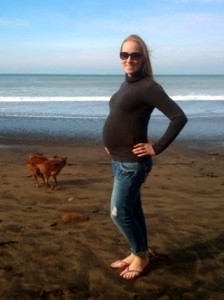
28-week bump update from the beach. Compare this to the beach photo in my previous post about week 12 to see how much I’ve grown. (Or look back two posts to see that I’ve maybe shrunk a little since Christmas without all the yummy treats around)
Misconception #7: Babies should be warm and cozy when they sleep. When we bought our new home, we knew it needed to have its ducts insulated, and I made sure we got it done quickly because I worried the baby would get cold in the nursery. Turns out the ideal sleeping temperature for babies is much cooler that I thought: according to Baby 411, the recommended safe room temperature to reduce SIDS risk is only 68 degrees. Interestingly, anything that can cause the ambient temperature of the crib to go up—like the adorable bumper pads that perfectly match my “Forest Friends” nursery theme—increases the risk of SIDS. The authors recommend hanging anything but the bare bones crib bedding on the wall as decoration. After reading this, I also opted to buy a crib that had slats on all sides to promote better ventilation rather one that had one or two stylishly solid sides.
Misconception #8: A fever of 101°F degrees is panic-worthy. The Fever-phobia section of Baby 411 was written for me, because I’ve been wracked with worry every time Richard has had a fever (once, I was up all night Googling “rabies” to rule it out for sure). I thought that 99°F was a fever and 101°F was a worrisome fever. It turns out that body temperature fluctuates quite a bit throughout the day. According to Baby 411, it’s coolest at 7am (as low as 97.6°F) and highest at 7pm (as high at 100°F). The true definition of a fever is a body temperature of 100.4 or higher taken rectally. So, 101°F is a low fever. The authors insisted on using a rectal thermometer, which I begrudgingly added to my baby registry—we’ll see if I actually muster up the nerve to use it (I also added an ear thermometer as a back up).
Misconception #9: Fever-reducing medicine prevents the baby’s brain from getting cooked. Baby 411 says that a fever cause by infection is unlikely to cause brain damage. Body temperatures over 108°F cause brain damage, but attaining that level of heat takes environmental factors (like leaving the baby in a hot car) to push body temperature this high. According to the authors, infections do not cause body temperatures over 106°F. Fever-reducing medicine is just to help the baby feel more comfortable. Thank goodness for one less thing to worry about with regard to both the baby and the husband.
Misconception #10: I’m vaccinating my baby, so she will be safe whether or not other parents vaccinate theirs. Vaccines have a couple legitimate risks (which Baby 411 goes over in great detail), but the rate of death and disability is much higher if a child actually gets one of the diseases we routinely vaccinate against. Some children are medically unable to get vaccinated (e.g. they’re allergic to a component of the vaccine), so I’ve also always felt a sense of social responsibility to get my children vaccinated to protect those that can’t be. However, even though I’m pro-vax, I’ve never felt the need to have advocate to others about it. I didn’t think others’ decisions would directly affect me or my vaccinated children. The authors brought up a couple points I hadn’t previously considered:
- Newborn babies don’t get all their vaccination on day one, so they depend on herd immunity (i.e. everyone else being vaccinated) to stay healthy. My baby will depend on everyone else being vaccinated.
- The lifesaving effects of vaccines are astounding, but most vaccines are not 100% effective. There are mutated versions of all those scary diseases that we can still catch. If another child gets sick with a mutated viruses (which is more likely with zero vaccination protection), my child may be at risk, even with a vaccination.
- If a high enough percentage of the population is unvaccinated, viruses are likely to mutate within their multitude of hosts, making vaccines less effective in those that do get their shots. All children (without medical contraindications) must get vaccinated for my child’s vaccination to be as effective as it should be.
It turns out we are in this together. Part of me wishes I hadn’t read this because it made me more judgmental of others’ decisions and more likely to ask the somewhat offensive question, “Is your child vaccinated?” before scheduling a playdate. Another part of me is grateful to be informed and hopes I’ll actually have the guts to pose that question.
Misconception #11: Kids shouldn’t drink from garden hoses because they contain bacteria. When we moved into our new home, I pondered over the various garden hose options at Lowe’s and forewent spending extra money on the safe-for-drinking hose. Now I wish I had splurged. The problem with garden hoses is not the bacteria, it’s that they contain lead. Yes, lead as in the neurotoxic heavy metal, ugh! Baby 411 recommends running to the hose for a minute to clear lead before filling a kiddie pool (from which children will inevitably drink).
Misconception #12: It’s harmless to share utensils with a baby. I would not have thought twice about this before reading Baby 411. According to the authors, tooth decay is contagious. By swapping saliva with the baby, you also share cavity-causing bacteria that can erode the baby’s new teeth. Who knew?
Misconception #13: TV is never good for kids. I’ve never had the intention of completely preventing my children from watching TV, but that doesn’t mean I thought TV was beneficial—I assumed that I’d need an occasional break from providing entertainment. For the most part, Baby 411 advocates against screen time. Young babies aren’t developmentally capable of understanding what’s on the screen, and that time in front of the TV takes away from time that could spent listening to parents talk or read, or playing with toys they do understand. However, there is evidence that educational programming is beneficial for kids, provided they can understand the content. The authors say “the magic age to understand TV is two years old.” This rules out “Baby Genius.” However, even after two years, the authors recommend limiting screen time (check out the book for more details).
Other interesting factoids from Baby 411:
- The average baby goes through 2300 diaper changes in the first year alone. Oh my god.
- Babies lose their hair around four months, and then grow new hair. Good to know ahead of time, that would have freaked me out.
- The authors say you can expect an infection every other week in the winter. You can also expect to catch many of the infections your child gets. Ick.
- There are studies that have found “babies conceived less than 12 months after the birth of the first-born child were three times more likely to be diagnosed with autism spectrum disorder. Babies conceived from 12 to 23 months after the birth of the first-born child had almost two times the risk of autism. And, even babies conceived 23-35 months after the firstborn child had a slightly greater risk of autism.” I had never heard this before. I had a sister close to my age, which I loved, but I will definitely balance that priority with this evidence when planning my next pregnancy.
After reading Baby 411 I feel like I know a little more about babies, but friends and family tell me that what sounds good, effective, and easy on paper in baby books often isn’t any of those things in real life. I’m sure after the baby is born I’ll be able to write a much longer “Misconceptions I Had About Babies” blog post than this (maybe even containing opinions that contradict what I wrote here) based on experience.



